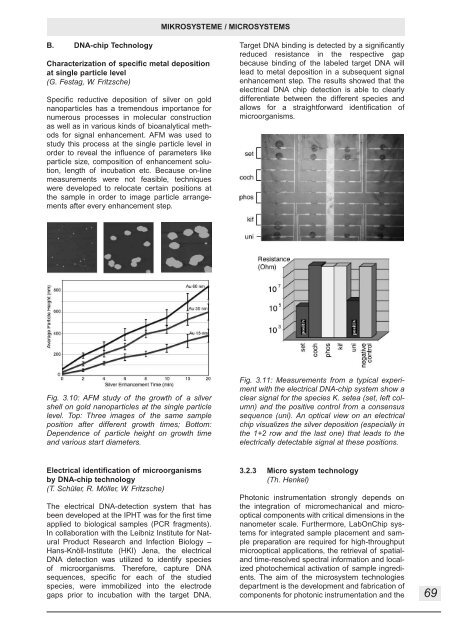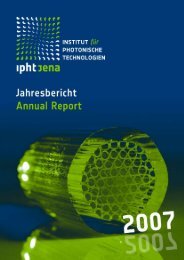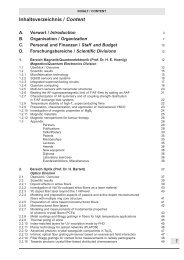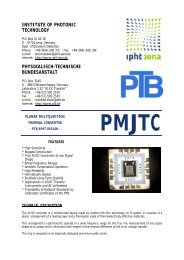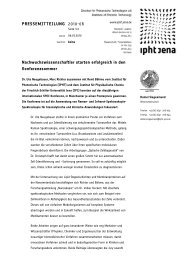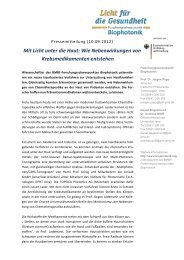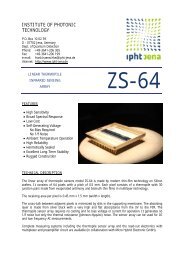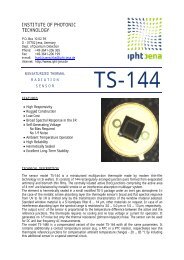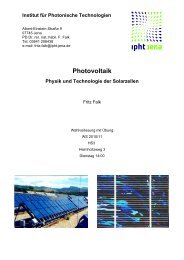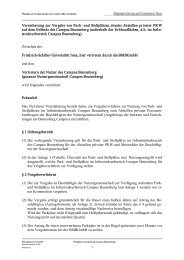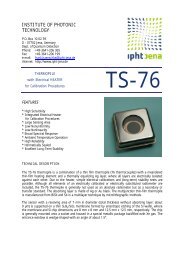Jahresbericht 2005 - IPHT Jena
Jahresbericht 2005 - IPHT Jena
Jahresbericht 2005 - IPHT Jena
Create successful ePaper yourself
Turn your PDF publications into a flip-book with our unique Google optimized e-Paper software.
B. DNA-chip Technology<br />
Characterization of specific metal deposition<br />
at single particle level<br />
(G. Festag, W. Fritzsche)<br />
Specific reductive deposition of silver on gold<br />
nanoparticles has a tremendous importance for<br />
numerous processes in molecular construction<br />
as well as in various kinds of bioanalytical methods<br />
for signal enhancement. AFM was used to<br />
study this process at the single particle level in<br />
order to reveal the influence of parameters like<br />
particle size, composition of enhancement solution,<br />
length of incubation etc. Because on-line<br />
measurements were not feasible, techniques<br />
were developed to relocate certain positions at<br />
the sample in order to image particle arrangements<br />
after every enhancement step.<br />
Fig. 3.10: AFM study of the growth of a silver<br />
shell on gold nanoparticles at the single particle<br />
level. Top: Three images of the same sample<br />
position after different growth times; Bottom:<br />
Dependence of particle height on growth time<br />
and various start diameters.<br />
Electrical identification of microorganisms<br />
by DNA-chip technology<br />
(T. Schüler, R. Möller, W. Fritzsche)<br />
The electrical DNA-detection system that has<br />
been developed at the <strong>IPHT</strong> was for the first time<br />
applied to biological samples (PCR fragments).<br />
In collaboration with the Leibniz Institute for Natural<br />
Product Research and Infection Biology –<br />
Hans-Knöll-Institute (HKI) <strong>Jena</strong>, the electrical<br />
DNA detection was utilized to identify species<br />
of microorganisms. Therefore, capture DNA<br />
sequences, specific for each of the studied<br />
species, were immobilized into the electrode<br />
gaps prior to incubation with the target DNA.<br />
MIKROSYSTEME / MICROSYSTEMS<br />
Target DNA binding is detected by a significantly<br />
reduced resistance in the respective gap<br />
because binding of the labeled target DNA will<br />
lead to metal deposition in a subsequent signal<br />
enhancement step. The results showed that the<br />
electrical DNA chip detection is able to clearly<br />
differentiate between the different species and<br />
allows for a straightforward identification of<br />
microorganisms.<br />
Fig. 3.11: Measurements from a typical experiment<br />
with the electrical DNA-chip system show a<br />
clear signal for the species K. setea (set, left column)<br />
and the positive control from a consensus<br />
sequence (uni). An optical view on an electrical<br />
chip visualizes the silver deposition (especially in<br />
the 1+2 row and the last one) that leads to the<br />
electrically detectable signal at these positions.<br />
3.2.3 Micro system technology<br />
(Th. Henkel)<br />
Photonic instrumentation strongly depends on<br />
the integration of micromechanical and microoptical<br />
components with critical dimensions in the<br />
nanometer scale. Furthermore, LabOnChip systems<br />
for integrated sample placement and sample<br />
preparation are required for high-throughput<br />
microoptical applications, the retrieval of spatialand<br />
time-resolved spectral information and localized<br />
photochemical activation of sample ingredients.<br />
The aim of the microsystem technologies<br />
department is the development and fabrication of<br />
components for photonic instrumentation and the<br />
69


